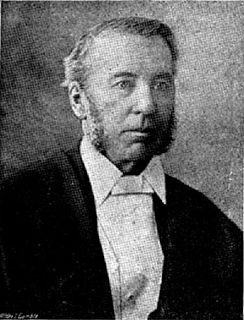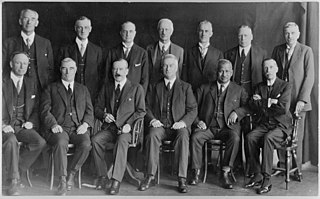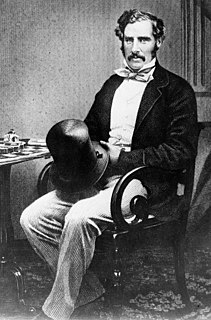
The 1949 New Zealand general election was a nationwide vote to determine the shape of the New Zealand Parliament's 29th term. It saw the governing Labour Party defeated by the opposition National Party. This marked the end of the First Labour government and the beginning of the First National government.

The 1951 New Zealand general election was a nationwide vote to determine the shape of the New Zealand Parliament's 30th term. The First National Government was re-elected, with the National Party increasing its parliamentary majority over the opposition Labour Party.

Sir Frederick Whitaker was an English-born New Zealand politician who served twice as the Prime Minister of New Zealand and six times as Attorney-General.

The New Zealand general election of 1875–76 was held between 20 December 1875 and 29 January 1876 to elect a total of 88 MPs in 73 electorates to the 6th session of the New Zealand Parliament. The Māori vote was held on 4 and 15 January 1876. A total of 56,471 voters were registered.

The New Zealand general election of 1879 was held between 28 August and 15 September 1879 to elect a total of 88 MPs to the 7th session of the New Zealand Parliament. The Māori vote was held on 8 September. A total of 82,271 (66.5%) European voters turned out to vote, plus 14,553 Māori voters. Following the election, John Hall formed a new government.

The New Zealand general election of 1911 was held on Thursday, 7 and 14 December in the general electorates, and on Tuesday, 19 December in the Māori electorates to elect a total of 80 MPs to the 18th session of the New Zealand Parliament. A total number of 590,042 (83.5%) voters turned out to vote. In two seats there was only one candidate.

Sir George Maurice O’Rorke was a New Zealand politician, representing the Auckland seat of Onehunga, and later Manukau, and was Speaker of the House of Representatives. He was a committed provincialist and was the eighth Superintendent of the Auckland Province. Upon receiving his knighthood in 1880, he became known as Sir Maurice.

Sir Roy Emile Jack was a New Zealand politician of the National Party. He was a cabinet minister and Speaker of the House of Representatives.
Sir George Alfred Arney was the second Chief Justice of New Zealand.

The United Government of New Zealand was the government of New Zealand from 1928 to 1931, defeating the long-lived Reform Government. The United Party had been formed in 1927 from the remnants of the Liberal Party under Sir Joseph Ward, who had made a political comeback. They did not manage an outright win, but formed a government with Labour Party support. However, Ward was in poor health and was eventually succeeded by George Forbes. The new cabinet was notable for its inexperience, with four ministers not having sat in the House of Representatives previously.

Hori Kerei Taiaroa, also known as Huriwhenua, was a Māori member of the New Zealand parliament and the Paramount Chief of the southern iwi of Ngāi Tahu. The son of Ngāi Tahu leader Te Matenga Taiaroa and Mawera Taiaroa, he was born at Otakau on the Otago Peninsula in the 1830s or early 1840s.
Dunedin Country was a parliamentary electorate in the rural area surrounding the city of Dunedin in Otago, New Zealand, from 1853 to 1860. It was a two-member electorate and was represented by a total of five members of parliament.

Edward Richardson was a New Zealand civil and mechanical engineer, and Member of Parliament. Born in England, he emigrated to Australia and continued there as a railway engineer. Having become a partner in a contracting firm, a large project caused him to move to Christchurch in New Zealand, in which country he lived for the rest of his life.

Seymour Thorne George was a New Zealand politician. The premier, Sir George Grey, was his wife's half-uncle and adoptive father, and that relationship resulted in Thorne George representing the South Island electorate of Hokitika despite him being based in the North Island. He later represented the Rodney electorate. Thorne George was later Mayor of Parnell.
The 6th New Zealand Parliament was a term of the Parliament of New Zealand.
The 7th New Zealand Parliament was a term of the Parliament of New Zealand.

The 29th New Zealand Parliament was a term of the Parliament of New Zealand. It opened in 1950, following the 1949 general election. It was dissolved in 1951 in preparation for the 1951 general election. The governing Labour Party had been defeated in the election by the National Party. This marked the end of the First Labour government and the beginning of the First National government.

The Hokitika by-election 1878 was a by-election held in the multi-member Hokitika electorate during the 6th New Zealand Parliament, on 26 June 1878. The by-election was caused by the resignation of incumbent MP Charles Button and was won by Seymour Thorne George, who defeated Gerard George Fitzgerald. Thorne George was suggested as a candidate by the premier, Sir George Grey; he was the Premier's nephew, and lived in the North Island.
The 1878 Waipa by-election was a by-election held on 24 July 1878 during the 6th New Zealand Parliament in the electorate of Waipa in the Waikato.




























